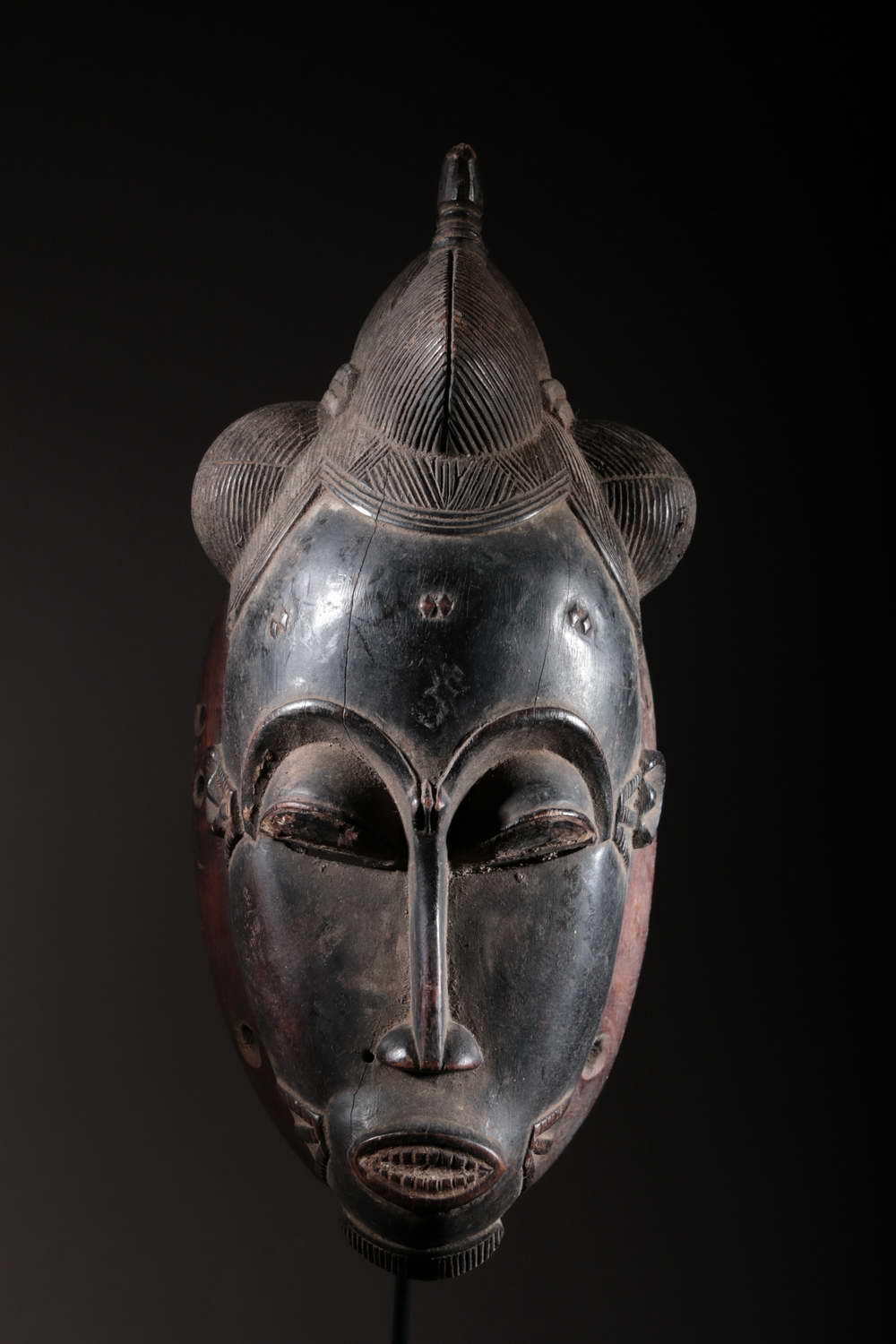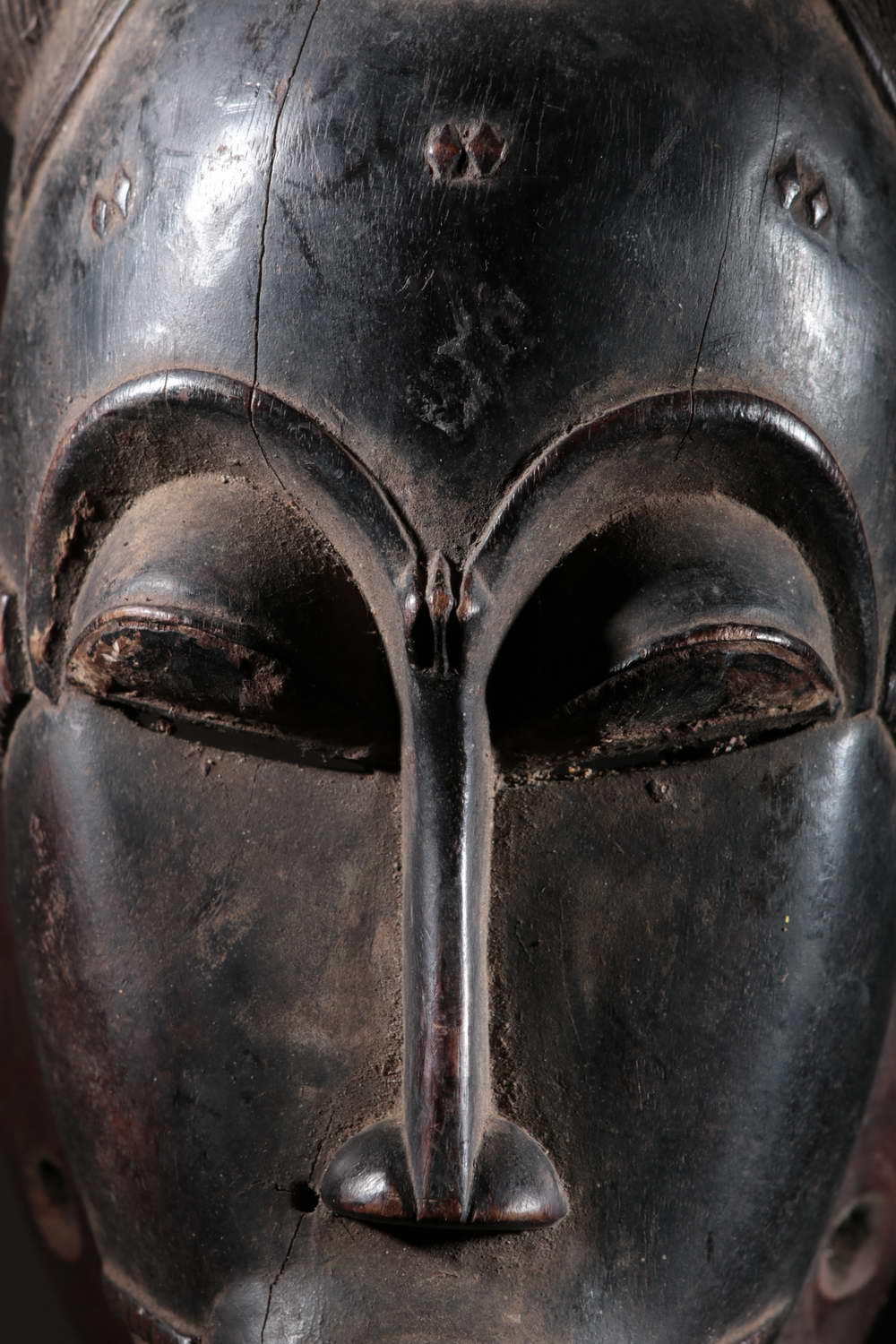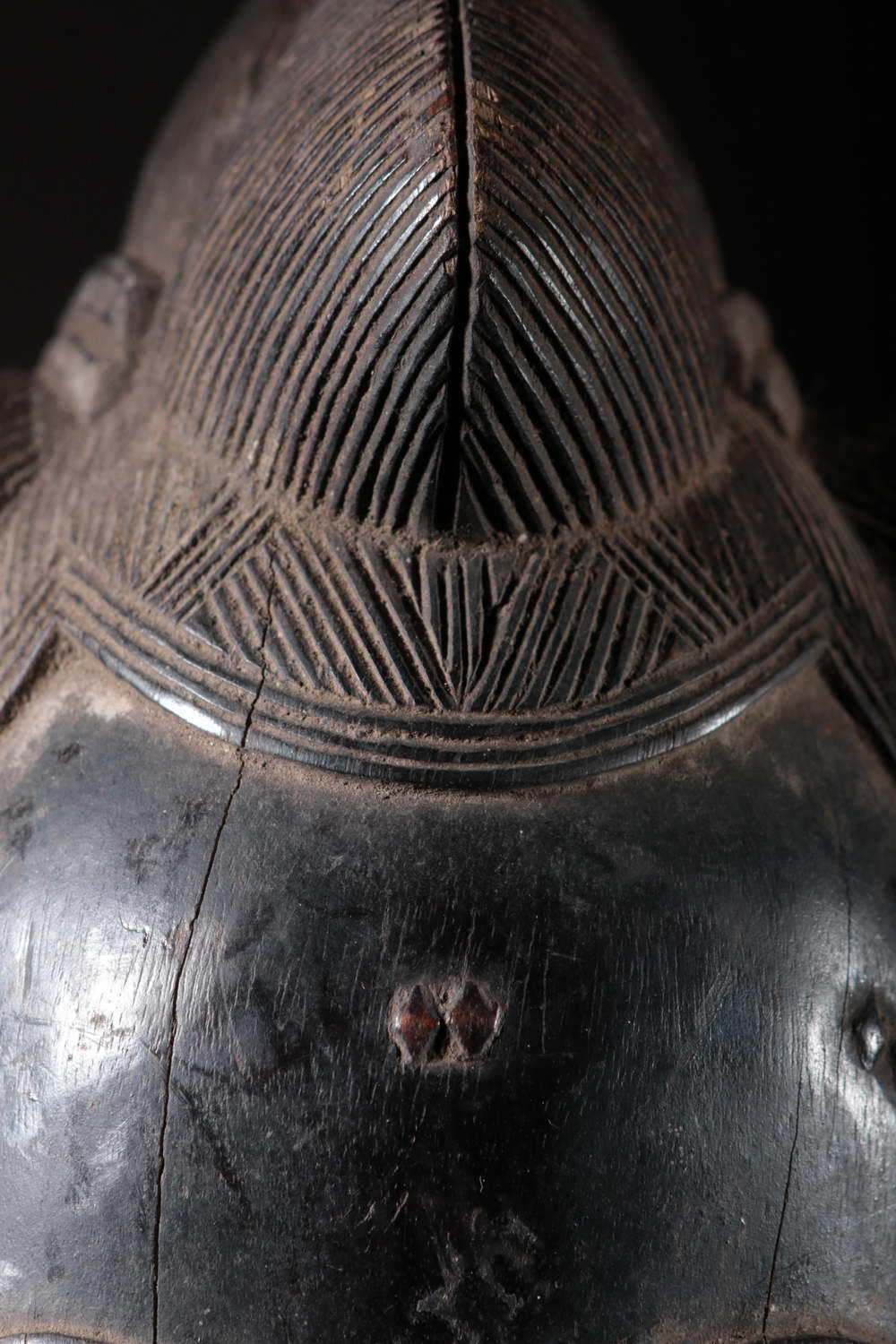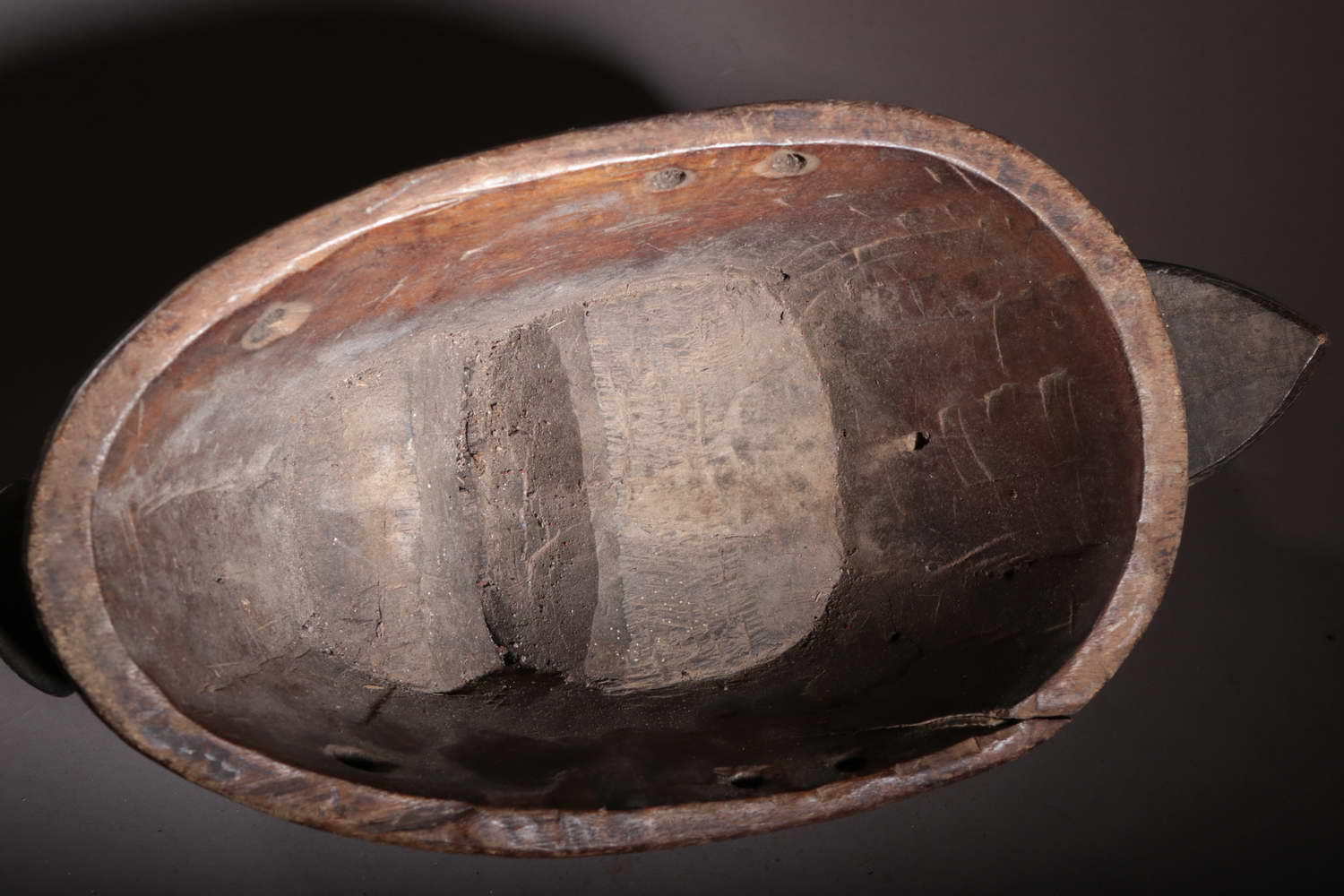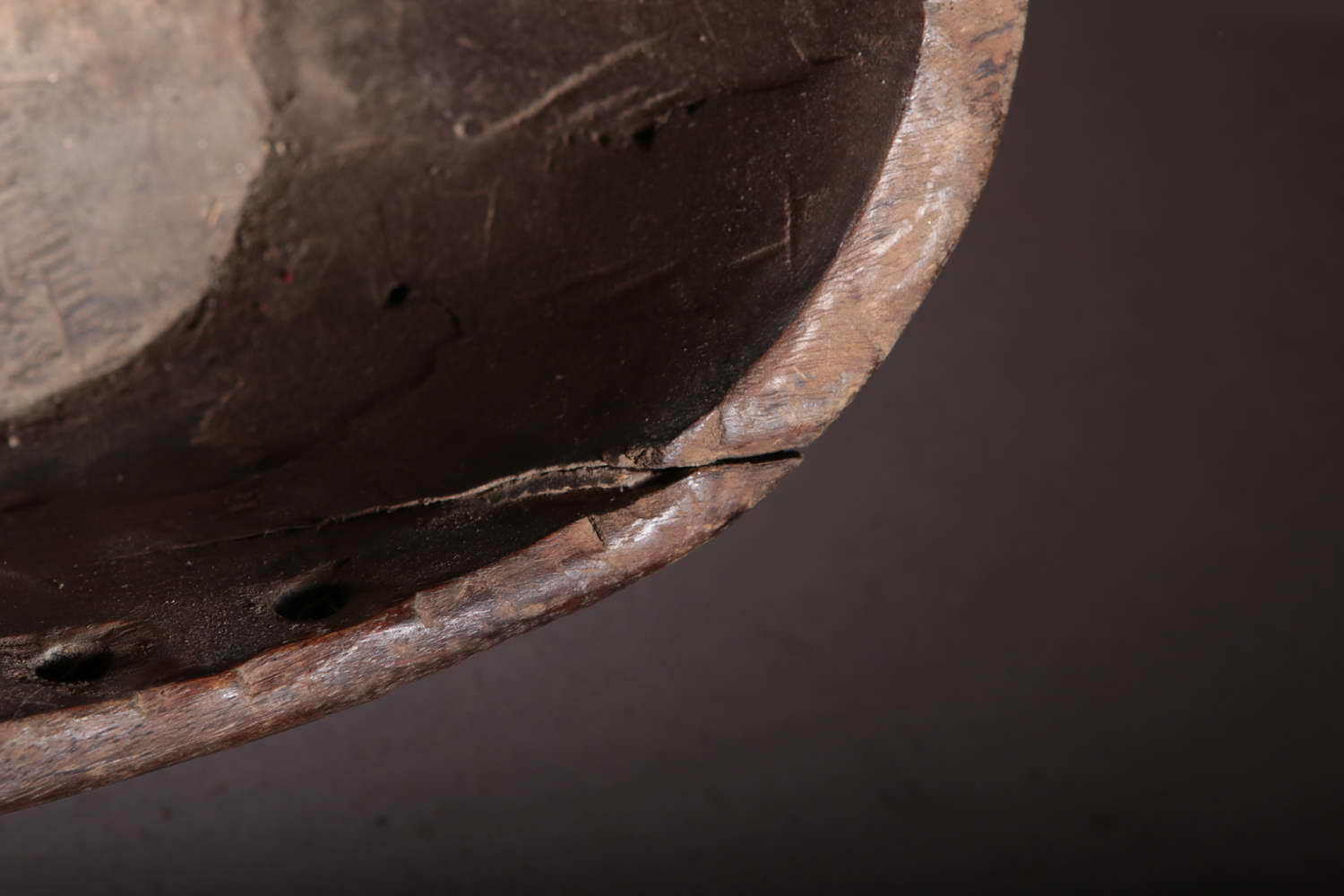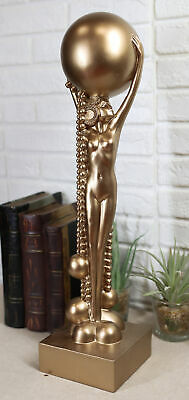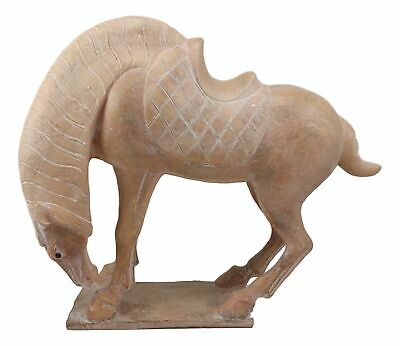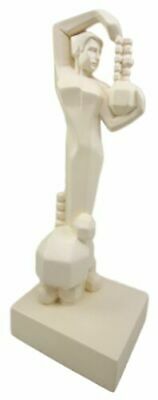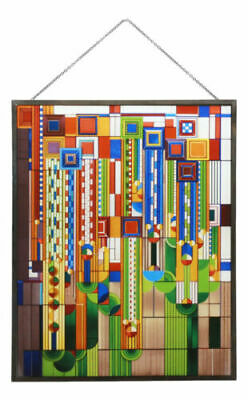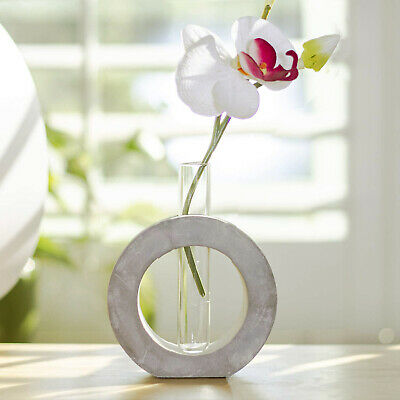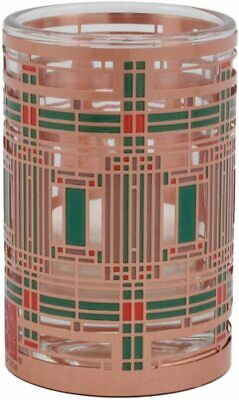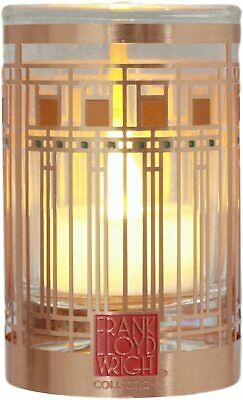-40%
Art African Mask Baoulé 1053
$ 353.06
- Description
- Size Guide
Description
Ref: m-1053Height: 36
CM
Product Description
Baoulé mask. Piece over 40 years old. Supplied on a base.
In African art, the art of the Baoulé occupies a special place. The finesse of the Baoulé masks and Baoulé statues makes them particularly accessible to Western tastes.
Baoulé sculpture on wood has the finesse of realization of goldsmith's work: the sculpture is very refined, the surfaces are very polished, the representation of scarifications, jewelry, hairstyle, face is done in a neat and meticulous way.
Among the African Baoulé statues there are two main types:
* Baoulé statues of husbands from beyond (blolo bla) or wives from beyond (blolo bian).
* Baoulé statues representing a spirit or genius of nature with the aim of appeasing them. Asiè usu statues ("genius of nature") are less frequent than (blo bla). The difference for differentiates them from each other and the following. The genius of nature is still seated while the bridegroom from beyond is still standing.
We distinguish in the Baoulé statues the evocations of spirits of nature (with sacrificial patina) and those of spirits conducive to romantic relationships (with polished patina). The first type of statue represents the spirits of the bush with ambivalent power, as often in Africa, who are feared for their malevolence: The statues of these spirits of the bush are honored to appease them and acquire their good grace and protection.
There are Baoulé masks of ancestors. Baoulé masks have the same characteristics as statues: elegant, finely carved and polished.
Otherwise there are zoomorphic Baoulé masks, reminiscent of the buffalo and the antelope. These masks are still worn by men. They have a different realization of the Baoulé portrait masks of ancestors, they are more conceptual and schematic because they represent spirits.
The Baoulé occupy part of central Côte d'Ivoire, both savannah and forest.
Baoulé statues
Baoulé statues correspond to 2 different types of worship:
One corresponds to the husband (wife) of the beyond who, in order to be appeased, calls for the creation of a Baoulé statue with the effigy of the husband (wife) of the beyond and an altar in the hut of the individual concerned. The need to have a husband or wife from the Hereafter is signaled by misfortunes and through a dream. This is, for example, as a result of sexual disorders in men, sterility in women. A man will have his wife blolo bian as a statue and a woman will have her husband from beyond blolo bla. This Baoulé statue must be taken with you on all trips. Its owner washes it, wipes it, nourishes it, caresses it: hence the beautiful patina of this kind of work. After the death of its owner, the statuette blolo bian or blolo bla is discarded or abandoned.
The other type of Baoulé sculpture will represent a spirit and will have the role of appeasing it. The Baoulé statues of spirit or genius of nature are always seated while the spouses from the beyond are still standing. We distinguish the spirits of nature asi asu with a sacrificial patina and the spirits conducive to romantic relationships with a polished patina. The spirits of the forest and the bush are imagined to be hideous: hunchbacks, feet turned back, dirty skin, red hair, with huge eyes and one arm ... Very dangerous, they can have a detrimental effect on agriculture, hunting, health. Softened by sacrifices, they can become auspicious for humans. It begins with a consultation with the diviner who identifies the cause of the misfortunes and prescribes remedies, consisting of sculpting Baoulé statuettes for which he indicates the sex, attitude, hairstyle and wood to use. The sculptor makes the Baoulé statuette by taking inspiration from the physical aspect of his client, possessed and in a trance. After the death of its owner, the Baoulé statuette is preciously preserved and the cult is continued by the descendants. The harmonious aspect of the statuettes of these spirits of nature, comes from the fact that they would not go to inhabit them if they were given the hideous forms which are theirs. These Baule statues have an idealized human aspect, with beautiful hairstyles and ethnic tattoos, which give them a civilized air to make them favorable to those who practice their worship. On these asi asu we notice the traces of sacrifices: food, raw eggs, blood of the victims, hence the crusty patina.
Baoulé masks
The Baoulé have masks, no doubt, under the influence of their neighbors Gouro or Sénoufo. There are Baoulé masks of ancestors but which now have a secular role and appear during entertainment dances. These portraits have the same characteristics as the statuary: elegant, finely carved and polished. They show great regional diversity in hairstyles and tattoos. . The double Baoulé mask represents the marriage of the sun and the moon or of twins whose birth is always a good sign.
Otherwise there are zoomorphic Baoulé masks, reminiscent of the buffalo and the antelope. They are always worn by men. They have a different realization of the Baoulé portrait masks of ancestors, they are more conceptual and schematic because they represent spirits. Formerly they were worn during funeral ceremonies to attract the graces of the afterlife, cure illnesses and ward off wizards. These Baoulé masks correspond to 3 types of dances: the gba gba, the bonu amuen and the goli:
The gba gba, of Gouro origin, is used for women's funerals during the harvest period. He celebrates beauty and age, hence the finesse of his features.
Bonu amuen protects the village from external threats. It forces women to exercise strong discipline and it appears during commemorations of the death of notables. The spirits of the bush have their own sanctuary in which they receive sacrifices. When the spirits intervene in community life, their masks take the form of a wooden helm representing a buffalo or an antelope and are worn with raffia costumes, metal bracelets at the ankles. The muzzle has teeth symbolizing the strength of the animal which must defend them.
The Goli can be danced both for entertainment and for funerals of important people. It was borrowed from the Wans after 1900. The kple kple mask has a round shape, surmounted by two horns. The male mask is red, the female mask in black (sometimes vice versa in some villages). He often appears as a pair in the Goli dance and is followed by a pair of zoomorphic helm masks (Goli Glen), then a pair of horned face masks (Kpan Pre) and finally two male head masks with braided hairstyles. peak (Kpan). Although each pair of masks include both male and female elements, the first two pairs are considered to have a predominantly male personality. Goli masks are larger and heavier than other Baoulé masks.
There is also a divination instrument called a mouse oracle, consisting of pottery placed on a wooden base. The oracle is made up of two communicating floors. On the upper floor, the diviner places food next to a turtle shell containing small bones or a piece of iron to which are attached small sticks decorated with pearls. We put the lid on the box and wait for the mouse to come up to eat the food. we then open the box and the diviner deciphers the message by analyzing the arrangement of the rods or bones moved by the mouse.
The Baoulé also created figures of monkeys, endowed with a prognathic jaw with pointed teeth, a grainy patina due to sacrifices, the monkey holds a cup or a pestle in his hands. Sometimes the monkey would intervene in rituals of divinations, sometimes it would be a protection against the sorcerers, sometimes a protective divinity of the agrarian rites, sometimes a genius of the bush. This cult would be relatively recent.
The sculptor Baoulé and his characteristics
The profession of sculptor is not hereditary and results from a personal choice or a desire which manifests itself during a dream or a crisis of possession.
Among the Baoulé, there is great mobility of people and works of art. These trips are also an opportunity to order a new type of sculpture or to adopt a new type of dance from another village. Artists may have learned in a workshop and perform very different works from that workshop. Artists travel and can sometimes work for clients who live far from home.
The Baoulé have a wood sculpture that has the qualities of goldsmithing: extremely refined sculptures, highly polished surfaces, representation of scarifications, hairstyle, jewelry made in a neat and meticulous way.
Baoulé statuary is characterized by a certain realism, with Baoulé canons of beauty: round calves for women, long hands with slender fingers, small buttocks. The harmonious hairstyle is made of many finely braided pigtails. The beard is neat and sometimes braided. The patina is smooth.
Baoulé religion and rituals
The Baoulé believe in a creator god called Nyamien, intangible and inaccessible. The god of the earth named Asia who controls men and animals. Spirits or Amuen are endowed with supernatural powers. The real world is the opposite of the spiritual world, called blolo, where souls come from at birth and return to at death. The main precept of religion is the recognition of death and the immortality of the soul. The ancestors are the object of a cult but are not represented. In the past, death was never considered natural. So we were looking for his manager. The heir was the brother or sister born to the same mother as the deceased, as it was considered that there is no certainty to be the real son of his father.
Rituals can change. The creation of a new cult can be decided following a dream or a crisis of possession during which the spirit reveals itself to the dreamer or to the possessed and explains to him the ritual, the rules and the objects that he he must acquire or manufacture.
The sculptures and the wooden masks make it possible to create a closer contact with the supernatural world.
The Baoulé believe that an individual includes a body, a double and a soul. Each being would have a respondent in the other world: blolo. To this celestial figure are consecrated statues to which offerings are made.
African art, African masks
Piece delivered with an invoice and a certificate of authenticity.
African art african tribal arte africana afrikanische kunst
The other type of Baoulé sculpture will represent a spirit and will have the role of appeasing it. The Baoulé statues of spirit or genius of nature are always seated while the spouses from the beyond are still standing. We distinguish the spirits of nature asi asu with a sacrificial patina and the spirits conducive to romantic relationships with a polished patina. The spirits of the forest and the bush are imagined to be hideous: hunchbacks, feet turned back, dirty skin, red hair, with huge eyes and one arm ... Very dangerous, they can have a detrimental effect on agriculture, hunting, health. Softened by sacrifices, they can become auspicious for humans. It begins with a consultation with the diviner who identifies the cause of the misfortunes and prescribes remedies, consisting of sc
